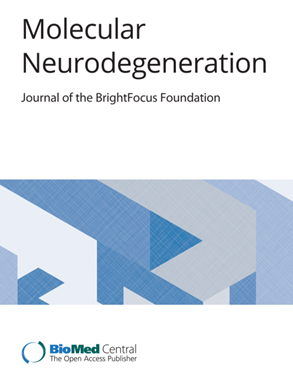以单细胞分辨率揭示帕金森病的细胞特异性反应
IF 14.9
1区 医学
Q1 NEUROSCIENCES
引用次数: 0
摘要
帕金森病(PD)是第二大常见的神经退行性疾病。帕金森病的病理特征是多巴胺能神经元的缺失和α-突触核蛋白的聚集,主要存在于中脑的黑质部位(SNpc)。然而,目前还不清楚导致不同细胞类型发生病变的分子机制。在此,我们对从 15 例散发性帕金森病(PD)病例和 14 例对照病例中获得的人类死后 SNpc 进行了单核转录组分析。我们的数据集包括 84K 个细胞核,代表了大脑的所有主要细胞类型,使我们能够获得这些细胞类型的转录组水平特征。重要的是,我们确定了每种细胞类型的多个亚群,并描述了特定的基因组,从而深入了解了这些亚群的不同作用。我们的研究结果表明,在帕金森病样本中,神经元细胞明显减少,同时胶质细胞和 T 细胞增加。亚群分析表明,在帕金森病样本中,富含酪氨酸羟化酶(TH)的星形胶质细胞、小胶质细胞和少突胶质细胞群以及富含TH的神经元显著减少。此外,对耗竭亚群的标记基因分析发现了 28 个重叠基因,包括与多巴胺代谢相关的基因(如 ALDH1A1、SLC6A3 和 SLC18A2)。总之,我们的研究为了解多巴胺能神经元变性和多巴胺依赖性脑病胶质细胞反应的分子机制提供了宝贵的资料,凸显了新型亚群和细胞类型特异性基因组的存在。本文章由计算机程序翻译,如有差异,请以英文原文为准。
Unravelling cell type-specific responses to Parkinson’s Disease at single cell resolution
Parkinson’s Disease (PD) is the second most common neurodegenerative disorder. The pathological hallmark of PD is loss of dopaminergic neurons and the presence of aggregated α-synuclein, primarily in the substantia nigra pars compacta (SNpc) of the midbrain. However, the molecular mechanisms that underlie the pathology in different cell types is not currently understood. Here, we present a single nucleus transcriptome analysis of human post-mortem SNpc obtained from 15 sporadic Parkinson’s Disease (PD) cases and 14 Controls. Our dataset comprises ∼84K nuclei, representing all major cell types of the brain, allowing us to obtain a transcriptome-level characterization of these cell types. Importantly, we identify multiple subpopulations for each cell type and describe specific gene sets that provide insights into the differing roles of these subpopulations. Our findings reveal a significant decrease in neuronal cells in PD samples, accompanied by an increase in glial cells and T cells. Subpopulation analyses demonstrate a significant depletion of tyrosine hydroxylase (TH) enriched astrocyte, microglia and oligodendrocyte populations in PD samples, as well as TH enriched neurons, which are also depleted. Moreover, marker gene analysis of the depleted subpopulations identified 28 overlapping genes, including those associated with dopamine metabolism (e.g., ALDH1A1, SLC6A3 & SLC18A2). Overall, our study provides a valuable resource for understanding the molecular mechanisms involved in dopaminergic neuron degeneration and glial responses in PD, highlighting the existence of novel subpopulations and cell type-specific gene sets.
求助全文
通过发布文献求助,成功后即可免费获取论文全文。
去求助
来源期刊

Molecular Neurodegeneration
医学-神经科学
CiteScore
23.00
自引率
4.60%
发文量
78
审稿时长
6-12 weeks
期刊介绍:
Molecular Neurodegeneration, an open-access, peer-reviewed journal, comprehensively covers neurodegeneration research at the molecular and cellular levels.
Neurodegenerative diseases, such as Alzheimer's, Parkinson's, Huntington's, and prion diseases, fall under its purview. These disorders, often linked to advanced aging and characterized by varying degrees of dementia, pose a significant public health concern with the growing aging population. Recent strides in understanding the molecular and cellular mechanisms of these neurodegenerative disorders offer valuable insights into their pathogenesis.
 求助内容:
求助内容: 应助结果提醒方式:
应助结果提醒方式:


